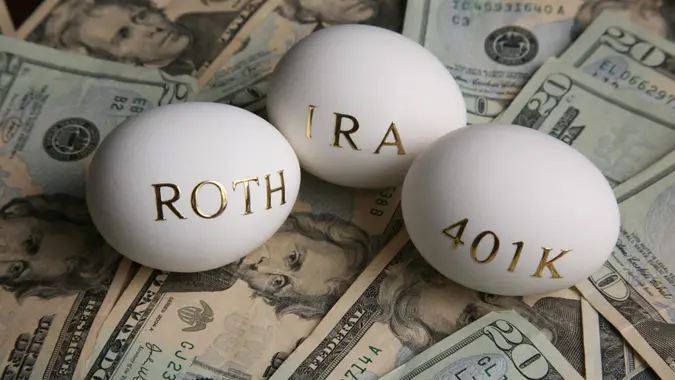4 Ways To Use Your 401(k) or IRA To Invest in Real Estate

Commitment to Our Readers
GOBankingRates' editorial team is committed to bringing you unbiased reviews and information. We use data-driven methodologies to evaluate financial products and services - our reviews and ratings are not influenced by advertisers. You can read more about our editorial guidelines and our products and services review methodology.

20 Years
Helping You Live Richer

Reviewed
by Experts

Trusted by
Millions of Readers
Everyone knows you should be saving for retirement, but when you break that broad concept down into the hows, wheres and whys, your investment strategy can feel a little convoluted. Before you dissect your taxable income, asset class, interest rates and the stock market, it may be time to try an alternative route.
A 401(k) and individual retirement account (IRA) are excellent ways to save for retirement because contributions and gains are tax-advantaged. While many individuals use these accounts to invest in stocks and bonds, under the right circumstances, you can also invest in real estate properties, the commercial real estate market or other ways to gain cash flow through rental income.
Here are four ways you can use your 401(k) or IRA to invest in real estate or commercial property.
Invest in REITs
Most employer-sponsored 401(k) plans are limited to traditional investment options through major stock exchanges like stocks, bonds and mutual funds. However, though typically retirement accounts aren’t used to invest in real estate, a limited number of 401(k)s may allow you to invest in real estate investment trusts (REITs).
Real estate investment trusts pool money from investors to purchase and operate investment properties. The types of investments REITs offer range from multifamily residential housing to warehouses, hotels, office buildings and shopping malls.
Some REITs trade publicly on stock exchanges, which means you can invest in a REIT through an IRA — and might be able to invest through your 401(k). One benefit of investing this way is that the dividends you earn grow tax-deferred.
Invest in a Self-Directed 401(k) or IRA
Whereas the typical 401(k) is sponsored by an employer, a self-directed 401(k) puts control into the account holder’s hands and allows for a wider range of investments, including alternative assets like real estate. A self-directed IRA can also invest in real estate.
Only a small number of employers offer self-directed 401(k)s, but solo 401(k)s for self-employed individuals with no full-time employees are always self-directed. With either type — or with a self-directed IRA — a custodian holds the assets on your behalf.
You do have to follow some rules, though. The purchase can’t benefit family members, for example, and the income you invest must come from a business activity other than real estate investing. Otherwise, you can use your funds to purchase real estate now and enjoy the gains in the future, after you retire.
Borrow Against Your 401(k)
Many 401(k) plans allow you to borrow up to $50,000 or half of your account balance, whichever is less, without penalty. You could, conceivably, invest the borrowed funds in real estate.
That said, it’s a risky way to invest with or without paying taxes upfront. You must repay the loan within five years — or almost immediately if you separate from the company. Otherwise, you’ll owe a 10% penalty if you’re younger than age 59 1/2, plus income tax on the distribution. In addition, you could miss out on growth if the real estate investment generates lower returns than the other investments in your account.
Make a Hardship Withdrawal From Your IRA
Special hardship provisions allow you to withdraw funds from your IRA without suffering the 10% early withdrawal penalty if you’re under the age of 59 1/2.
Qualified homebuyers can withdraw as much as $10,000 for a first home purchase. This is true for both traditional IRAs and Roth IRAs, but with Roth IRAs you need to have held the account for at least five years.
The hardship penalty exception does not apply to 401(k)s.
Final Take To GO
The bottom line is that there is not just one path you can take toward successfully boosting your retirement savings. Your 401(k) and IRA accounts are precious commodities so it’s normal to have some hesitation in pitting them against an uncertain real estate market. However, without risk there are fewer rewards, or at least fewer rewards with a high ROI.
Daria Uhlig contributed to the reporting for this article.
 Written by
Written by  Edited by
Edited by 

























